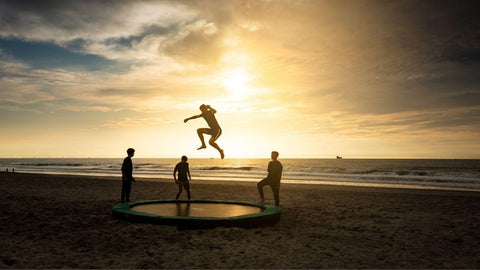Many parents are concerned about trampolines injuring their children. A properly designed trampoline is as safe as a bike or a swing when used properly. Especially for youngsters, jumping on a trampoline provides a number of strengthening advantages. The trampoline is primarily used to develop a child's sense of balance. Walking or crawling on the trampoline can help a one-year-old youngster who is just learning to walk. A trampoline promotes balance, motor function, muscle strength (particularly in the legs and back), and general fitness. For many people, trampoline jumping is simpler to inspire than running on a treadmill. Considering these benefits, a trampoline may be a great addition to your yard.
Safety net advice
Just as while riding, a safety net should be used when jumping on a trampoline. The safety net prevents you from falling on the trampoline's edge. While it is critical that the trampoline be safe, the safety net must also be appropriate. So, if you buy a trampoline, we strongly advise you to get a quality net as well.
Trampoline facts
Springs
The springs and jumping mat allow the user to bounce up and down while stretching. Trampoline springs are tension springs of the cylindrical coil kind. Normally made of galvanized steel wire spiraled into a cylinder. The springs impact the trampoline's quantity, length, material quality, steel wire thickness, and diameter. The coil's diameter affects its ability to expand. Less wire means less resistance to extension, therefore longer springs are simpler to stretch than shorter ones. More springs mean less strain on each spring, which means higher bounce and longevity.
Cheap trampolines have tiny, rigid springs and a brief, muffled bounce. They are also less common than on excellent trampolines. The springs on premium trampolines are bigger, longer, and more numerous, providing a deeper and more powerful bounce. Cheap trampolines have weaker springs, but they seldom break. They can be overstretched by extreme pressures.
Shape
The design of a trampoline affects the bounce as well as other features. The most common shape for a family trampoline is round. This design offers symmetrical force distribution in the center of the mat, and asymmetrical force distribution away from the center. Rectangular and oval trampolines offer a deeper, more regulated bounce. Circular trampolines have the benefit of orienting the user towards the center, preventing falls.
Jump mat
Trampoline qualities are influenced by the jumping mat. The jumping mat should be constructed of UV-resistant polypropylene fabric. This keeps the mat from being sun-bleached and prolongs its life. The cloth also offers enough friction on the leaping surface. A low friction carpet is easy to slip on, increasing the risk of injury. The risk of sliding is highest when the mat is moist, like after a storm or early morning dew. If the mat is excessively slippery, you will suffer burns. This is typical with inexpensive jumping mats made of inferior materials. Polypropylene mats are popular as premium family mats since they satisfy all of these criteria and are low-maintenance. However, there are varying grades of polypropylene mats, with the cheaper being coarser.
Edge defense
The edge guard prevents the jumper from falling on the frame or springs and injuring themselves. In terms of safety, the edge protector is the trampoline's most critical component. With the exception of the frame, the edge protector is the most costly component. Good edge protection is expensive to build, therefore this is where most "low-cost" versions take shortcuts. As a result, these trampolines are frequently unsafe. Also, inexpensive edge protection soon fades off due to the sun's UV rays, necessitating replacement after just a few summers. Quality edge protectors are composed of EPE or EVA. This makes them weather and wind resistant. Even these edge guards eventually wear out, although they generally have a far longer lifespan. More essential, high-quality edge protection protects the user from harm.
The best edge protectors cover the frame, springs, and spring brackets properly. It's also well-secured, keeping it from shifting during jumps or in strong gusts. To avoid splintering if you accidentally land on the edge guard, it should be thick and shock-absorbent. Good edge protection is two millimeters thick. In addition to striking the frame, it is typical for the user to get their foot caught between two springs, causing the edge protection to buckle and shatter.
Cheaper trampolines generally include polyurethane foam within the outside shell, which is inexpensive but not shock-absorbing. The substance also absorbs water, causing the foam to rot and shatter.
The exterior casing material must also endure abrasion and UV radiation. In the worst situation, inexpensive trampolines are constructed of reinforced PE plastic, the same material as cheap tarpaulins. Better is reinforced PVC, used in rainwear and luggage.
Frame
The frame of the trampoline is its skeleton, supporting the whole design. Even with low-cost trampolines, the structure is usually robust enough to resist overloading. A cheap and thin frame, on the other hand, readily bends. Galvanized steel frames are used to avoid rust. The frame must also be galvanized both inside and out to prevent corrosion. It is also critical to clean the welds between the leg and the ring completely after welding to provide long-term corrosion protection. Otherwise, the welds create the frame's weak spot, where corrosion might start. A frame with thick welds is not only stronger but also more stable. It is, of course, heavier. So a hefty frame is typically a good thing.
Service
When buying a trampoline, strong after-sales service is crucial. Partly because it is a costly item, and partly because it is bulky and cumbersome, making it difficult to return. So be sure the store you got it from can quickly respond to queries regarding installation and provide replacement components if something fails.
If you plan to maintain the trampoline for several years, spare parts availability is critical. Low-cost trampolines are frequently replaced by new versions from new manufacturers. If you're unfortunate, a year-old cheap trampoline may be hard to get a spare component for. Cheap trampolines frequently break, necessitating more extra components. Renowned quality brands typically have a completely different range continuity, so manufacturers may offer spare parts long after you bought the trampoline. This helps a quality trampoline last longer than a cheap one.
Size
The size of a trampoline influences both jumping space and bounce. The bigger the trampoline, the heavier the user must be. If the user is too light for the trampoline, the jumps are slow and you can't start a proper bounce. The air under the trampoline is continually pushed in and out by the jumping mat. This air movement saps the kinetic energy from the bounce, thus the user must either be hefty or leap high enough to compensate. That is, you must be hefty enough to use your body weight to squeeze out enough air during each jump.
The fact that the largest common size for family trampolines is 14 feet in diameter is not by chance; it is simply because this size allows for ample jumping space, even for little children. Trampolines come in 11 foot, 16 foot, and 17 foot sizes!




























Comments (0)
There are no comments for this article. Be the first one to leave a message!